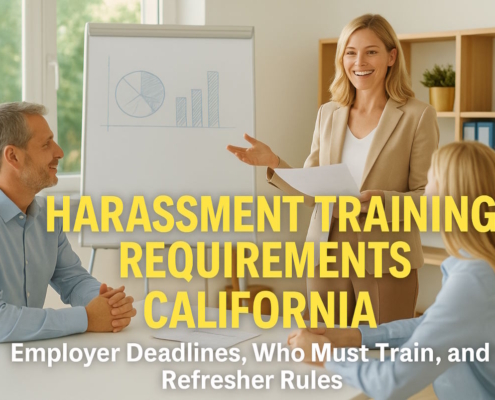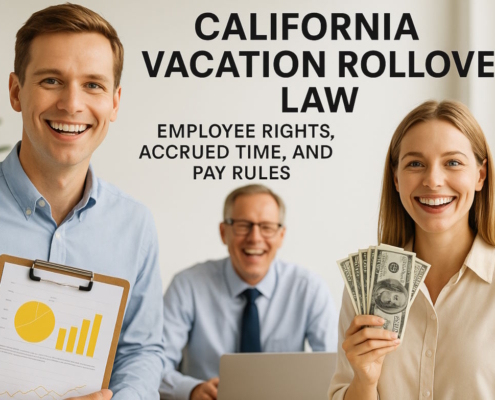CA-Exempt Employee: What exactly is it?
According to California law, an “exempt” worker may receive a salary and be excluded from overtime compensation, meal and rest breaks, certain record-keeping requirements, and some additional rights afforded to nonexempt workers. One of the most significant choices that a company has to make before granting employment to a candidate is whether the candidate is a CA-exempt worker or not.
Regretfully, companies in California often struggle with this kind of problem and occasionally make poor decisions. When an employee is mistakenly designated as exempt, they have the right to sue their employer for lost pay and other significant statutory fines. A misclassification case can be expensive to defend or settle.
The Wage Orders of the Industrial Welfare Commission (California)
The very first wage order was given by the IWC (Industrial Welfare Commission) in the year 1916, setting the minimum wage at 16 cents per hour. There are now seventeen wage orders in all. Different occupational groups are covered by each wage order, such as the “Manufacturing Sector” (Wage Order 1). Numerous employment laws, such as those pertaining to minimum & overtime pay, work hours and days, alternative weeks of work, and meal & rest breaks, are outlined in wage orders. Additionally, the Wage Orders outline the five circumstances in which a staff member may be deemed exempt.
Five exemptions
Provisions governing the classification of a worker as a CA-exempt employee or non-exempt are found within each of the wage orders. In California, the Wage Orders recognize just five types of exemptions. The following are the five main exemptions:
- Executive Exemption;
- Administrative Exemption;
- Professional Exemption;
- Inside Salesperson Exemption; and
- Outside Salesperson Exemption.
1. Executive Exemption
The Executive Exemption for California is really simple. It mandates that the worker perform tasks linked to the administration of the business, routinely oversee two or more workers, participate in decisions pertaining to employment, such as hiring and dismissing, and “customarily and regularly exerts discretion & independent judgment.” Over half of the employee’s time must be spent performing tasks that satisfy the exemption’s requirements. Additionally, the worker must get a salary each month that is at least double the minimum wage set by the state.
To put it simply, the Executive Exemption mandates that the employer evaluate the job that the employee actually does on a regular schedule and refrain from using titles alone to justify the classification. The exemption status of a worker is subject to change, just like any other exemption. For instance, a CA-exempt employee within the Executive Exemption—which necessitates the oversight of two or more workers—may no longer be eligible if their team of two employees is permanently reduced to one.
2. Administrative Exemption
Employees who perform reasonably high-level work directly relevant to management strategies or the employer’s or its clients’ overall business operations are excluded from the Administrative Exemption. A worker is unlikely to be a CA-exempt employee if they work mostly in low-level manufacturing duties with a small amount of administrative work thrown in, such as serving as an assistant in administration to a low-level manager. However, the CEO’s executive assistant may fall under the Administrative Exemption and spend the majority of their time on more advanced exempt duties.
For many years, governmental organizations and courts have struggled with this exemption. The conclusion of any controversy involving the implementation of the Administrative Exemption is undoubtedly fact-intensive. An examination of the company’s reasonable expectations—what the company hopes the worker would accomplish—as well as the worker’s actual output, is necessary.
Fundamentally, the exemptions from the Wage Orders are qualitative as well as quantitative. What kind of job is the purportedly exempt work, and what amount of time is the employee spending on it? In a wage and hour case, proper classification is considered an affirmative defense, meaning that the employer must demonstrate at trial that it was the right choice about the worker’s exemption status.
3. Professional Exemption
Law, medicine, optometry, dentistry, engineering, architecture, accounting, and teaching are among the eight professions listed in the Professional Exemption as being excluded from the initial 12 parts of the Wage Orders. It also discusses a few additional occupations, such as software developers, nurses, and pharmacists.
Wage Order 4-2001(Section 3) contains all of the information. The employee must be working in “an occupation usually regarded as a scholarly or creative vocation” in order to qualify for the exemption.
The individual must possess advanced expertise in the field of their work in order to meet the “learned profession” criteria. As opposed to general academic education, apprenticeships, and training in the execution of regular mental, physical, and manual procedures, or work that is an integral part of or inevitably incident with any of the aforementioned work, this type of knowledge is “customarily acquired by an extended course of focused intellectual education and study.”
The alternative, “arts profession,” requires that the work be “original & creative” and the product of “the employee’s ingenuity, imagination, or ability or work that is an integral part of or inevitably incident in the course of the aforementioned employment.”
The work must fall into one of two categories: “predominantly cerebral and diversified in character.” The employer is required to frequently use “discretion & independent judgment” and make at least twice the minimum wage set by the state for full-time workers.
A review of the job being done, what the company would have expected the employee to undertake, and the length of time spent on exempt activities is all necessary to demonstrate the Professional Exemption, with the exception of the professions specifically included in the Wage Orders.
4. Inside Sales Exemption
Two requirements must be satisfied for an employee who works mostly at the business’s office—even a home office—selling goods or services for their employer to be free from overtime. First and foremost, the worker must receive pay that is greater than 1.5 times the minimum wage. The second requirement is that sales commissions must account for over half of the employee’s weekly pay.
The staff member is exempt from the daily & weekly overtime compensation requirements if both of these requirements are satisfied. During a workweek, the employee has the right to overtime compensation if either of the requirements is not fulfilled.
When an inside salesperson’s commissions do not exceed half of their overall pay, they may be a CA-exempt employee in some weeks & non-exempt in others. The test’s second section may surprise employers. Some salespeople receive commissions of several thousand dollars for sales that require months to go from offer to contract, particularly in Silicon Valley and the Bay Area.
As a result, an employee may put in a lot of overtime to close a contract without receiving any commissions. The employee may be eligible for overtime compensation for the entirety of the overtime hours spent on the deal if the contract for commissions specifies that the salesman only receives the commission income when the customer pays.
Companies that decide to offer a salesperson a high yearly salary in addition to commissions may be forced to pay overtime compensation for all overtime hours performed in weeks when commissions from sales make up less than half of the employee’s pay.
5. Outside Sales Exemption
Outside salespeople are CA-exempt employees as per the California Wage Orders.
Any person, with a minimum age of eighteen years, who devotes over fifty percent of his/her working time not at the place where their employer carries out business, to sell tangible or intangible commodities, or produces contracts to sell services, commodities, or uses facilities is an outside salesperson.
This means that even where specific circumstances are met, outside salespersons are not entitled to minimum wages, overtime pay, lunchtime, or rest time, among others. But not every time is it clear what an outside salesperson is considered to be. The decision of classification is highly fact-specific. The California Supreme Court clarified in Ramirez v. Yosemite Water Inc. that it is critical to consider both the company’s reasonable expectations and the actual job completed by the employee.
The trial court ought to additionally take into account whether the employee’s actions deviate from the employer’s reasonable expectations, whether the company’s dissatisfaction with an employee’s poor performance was expressed in a tangible way, and whether these statements were reasonable in light of the job’s real requirements.
Misclassifying a worker as an inside salesman can have serious repercussions for both the worker and the organization, just like any of the five exclusions.
Poor Classification Choices Have Negative Effects
Attorney expenses and settlement costs for just one plaintiff misclassification action can easily exceed $100,000 for an employer. Multiples of this number may be presented to an employer in a class action or multiple plaintiff case. An example of a typical misclassification instance could be as follows:
To seek long-term agreements with other companies to use its online database management system, a tech company keeps a sales team of twenty employees. The entire crew is designated as exempt by the company. Each team member conducts the same type of research and makes presentations to other companies about their company’s product. Every team member reports to a supervisor at the director level. In addition to sales commissions at varying rates based on seniority and production, they are all given $120,000 annually.
One of the team members leaves or is fired. They get in touch with a lawyer after reading about misclassification on the internet. A few weeks later, their lawyer sued the business for misclassification, claiming that the client was eligible for overtime pay because she was not exempt. For the fifty-two weeks that she performed for the company, she was eligible for 20 hours of extra pay per week because she usually worked sixty hours per week.
According to the legislation, she is only paid for 40 hours each week out of her $120,000 yearly pay. Her annual compensation is equivalent to $57.69 an hour. Her overtime charge of $86.54 must be compensated for all of the unpaid time since she received compensation for 40 hours per week. After 52 weeks of working 20 hours a week (1,040 hours), the unpaid overtime comes to $90,001.60—over an entire year!
She will prevail unless her employer can demonstrate that she was appropriately exempt within one of the exemptions, in which case the business will be required to reimburse her for the overtime not paid, interest at a rate of 10% annually, various statutory charges, and legal fees and costs. The former salesperson’s attorneys have just set the stage for a six-figure or possibly seven-figure compensation if the misclassification is accurate.
The lesson is to do things correctly and to keep them that way
This scenario is very typical of California misclassification issues. Due to the nature of the dangers that employers incur, very few cases involving misclassification make it to a jury. The majority are settled through a private agreement.
The courts in California have ruled that in order to decide whether to classify a worker as a CA-exempt employee or not, a company must consider the precise task that the employee is expected to accomplish. It’s not always simple to determine whether employees are entitled to overtime compensation or not. The case history is replete with rulings that specify who is and is not exempt, and the evaluations are intricate. Furthermore, a worker’s classification may alter over time.
Regular reassessments of employees’ exemption standing can be beneficial. One method to make sure a business decision stays the appropriate one over time is to incorporate exception analysis into annual evaluations.































